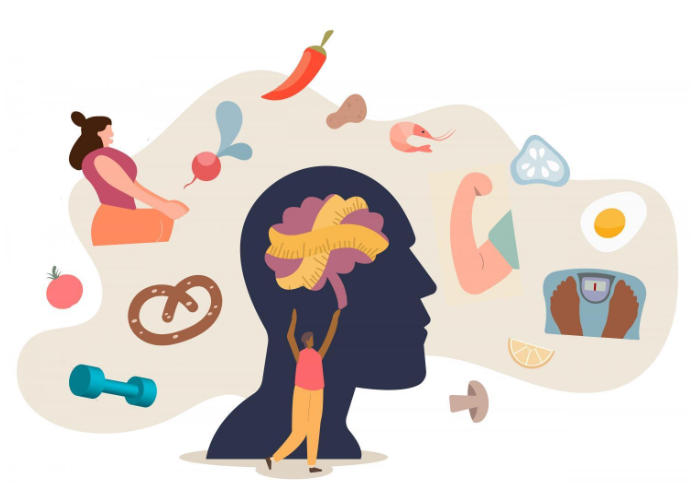By Blaise Dupont, Year 12
Eating disorders are a subtype of brain disorders that affect eating patterns and one’s overall relationship with food. These disorders can be a result of genetic predisposition (if a relative happens to have dealt with eating disorders), neurological conditions (neuropathology of hypothalamic mechanisms that regulate metabolism and eating behaviours), environmental factors (including physical, social or even economical) or psychological trauma. Individuals with eating disorders may be predominantly preoccupied with their eating habits, dieting and food restrictions. In fact, it is quite common for individuals with eating disorders to also experience body dysmorphia or a similar struggle with their confidence and appearance which would encourage them further to endorse unhealthy eating habits.
There exists a number of eating disorders. These include:
- Anorexia Nervosa: Anorexia is notoriously known as being one of the most dangerous and life-threatening eating disorders as it often implies a serious restriction of an individual’s diet. This disorder tends to develop within adolescence or young adulthood and is commonly a result of a discomfort regarding one’s body. Individuals with this disorder will consistently view themselves as being overweight despite being critically emancipated. This is often accompanied by extreme diets and/or the complete removal of certain foods, which can be detrimental to their health. As this particular eating disorder is strongly overlapped with anxiety, it can cause individuals to experience great bounds of anxiety proportional to the fear of gaining weight. There is a strong comorbidity between Anorexia and Obsessive-Compulsive Disorder. This, too, is strongly correlated to self-esteem issues and an obsession with thinness and the sensation of emptiness.
- Bulimia Nervosa: Similarly to Anorexia, Bulimia develops around the years of adolescence and is typically a result of an anxiety-related struggle. individuals with this disorder will have periods of strong bingeing in which they will be incapable of regulating how much they are eating, contrasted with great periods of borderline starvation. Individuals will utilise other means to lose weight such as vomiting, fasting, laxatives, diuretics, enemas and excessive exercising. Individuals will experience recurrent episodes of binge eating followed by great purging acts, and persistent thinking patterns related to body image and self-esteem.
- Binge Eating Disorder: Also developing around the years of adolescence, Binge Eating Disorder is one of the most prevalent forms of eating disorders. It also follows the pattern of extreme binge eating periods, but without the purging. These individuals do not necessarily restrict themselves nor follow any particular diet, they do not perform any purging acts. The focus is less on weight loss and rather on filling a void in one’s heart. It allows an individual to relieve great bounds of anxiety, as this particular disorder is strongly correlated to anxiety disorders. There is also a dominating feeling of guilt and shame in regards to the bingeing behaviours that contribute to the low self-esteem typically associated with eating disorders.
- Pica: This disorder is unlike the preceding disorders and is characterised by the consuming of nonedible material, such as soap, hair or paper. The disorder can develop at any point in life and is a lot more common than expected. It is especially common with individuals with intellectual disabilities, neurological disorders such as ASD, or Autism Spectrum disorder, or even other mental disorders such as schizophrenia. Individuals with this disorder risk poisoning themselves or even cause themselves nutrient deficits that can lead to deadly consequences.
- Rumination Disorder: This particular eating disorder is characterised by the regurgitating of ingested food. It can be both a psychological and physical issue in which the stomach brings the ingested food back into the oesophagus and back into the mouth. The individual would then swallow the food once again. This disorder is common in younger children and tends to leave on its own. If this disorder does not improve past infant years, it can cause severe weight loss and malnutrition, it can be fatal. In adults, this disorder can manifest as extremely restrictive eating patterns, also leading to weight loss.
- Avoidant/Restrictive Food Intake Disorder: This disorder is very common in individuals on the neurodivergence spectrum as it is strongly linked to sensory processing disorders and sensory issues. The disorder is characterised by a general distaste in eating, or of specific foods in regards to taste, smell, texture, etc. Individuals with this disorder will often avoid certain foods, missing out on valuable nutrients and needing supplements. These individuals may also suffer great weight loss as the disorder can interfere so badly with everyday life that it can cause them to refuse to eat at all.
There exists other eating disorders that were not mentioned here, such as Purging disorder, Night Eating syndrome, or OSFED. Although these disorders do not appear as a big inconvenience when one does not suffer from them, these disorders can be extremely dangerous and cause serious problems not only physically but psychologically. Eating disorders, just like with all other disorders, are a source of great pain and struggle and it is important to be patient and understanding with individuals who endure the symptoms. Individuals, especially children and adolescents, with food disorders are often seen as ‘picky’ or even ‘dramatic’ when it comes to eating. This is why it is crucial to be aware of the difficulties that come with eating disorders and show empathy towards the individuals struggling.



